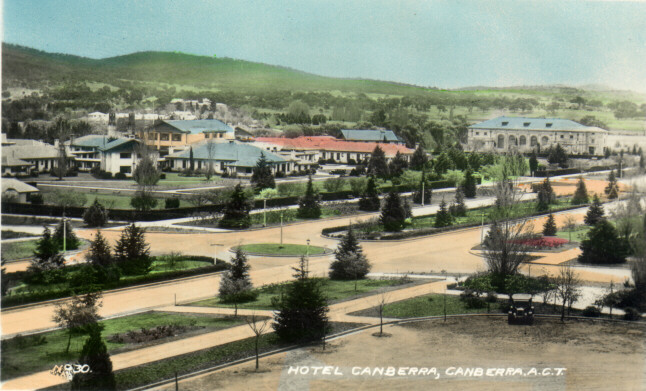Hotel Canberra |
The Hotel Canberra, originally Hostel No. 1 and now the Hyatt Hotel Canberra, was proposed early in 1921. The hostel was to accommodate 200 Parliamentarians, dignitaries and high Commonwealth officials in sophisticated simplicity and was intended to raise the public image of the new capital. Commonwealth Architect John Smith Murdoch recognised the importance of privacy and more home-like conditions and designed an arrangement of ten alternating single and two storied pavilions radiating from two garden courtyards, all set in a larger garden. The pavilions are linked by enclosed glazed verandahs to a central administration and dining block, to form a figure eight.
The hotel faces Commonwealth Avenue and occupies the block between Coronation Drive and Kaye Street. Its Garden Pavilion style is characteristic of 1920s Canberra and the garden city ideas of the time. The gardens were designed by TCG (Charles) Weston. His first garden plan was for a mediterranean style more suited to the dry climate and lack of water. He was persuaded by general opposition together with an improved water supply and the development of a suitable grass species to redesign the garden, which today retains much of the original planting and layout. The golf course was situated just behind the hotel, and tennis courts, a bowling green (based on the Chatswood Bowling Club in Sydney) and croquet lawn were established for guests. The croquet lawn remains but is no longer part of the hotel.
The hostel opened in two stages, on 24 December 1924 and 15 December 1925. Sale and purchase of alcohol was banned in the Territory until 1928, but in January 1925 the designation was changed from hostel to Hotel. A liquor licence was received on 22 December 1928. There were no public bars in Canberra; alcohol was served only in hotel lounges and dining rooms or in cafes. In 1949 a separate building was constructed behind the hotel to house the public bar (now called the Back Bar) that previously occupied valuable residential space in one of the pavilions.
Despite the lack of alcohol, the hotel became the centre of Canberra social life, reaching its heyday in the 1950s. An early suggestion to alter the hotel to provide a permanent dance hall was opposed by Murdoch, who suggested that a dance hall, casino and refreshment club be built behind the hotel. The role of community hall was taken on by the Albert Hall, opened next door in 1928.
When the hostel opened, not all pavilions were used for accommodation. The first guest in 1924 was WG Duffield, who set up the Commonwealth Solar Observatory in one wing until it was moved to Mt Stromlo in mid 1927. In 1933 the hotel set up a stenographic and copying service for guests. The hotel was for some time the only building in town with lockup facilities, so it often held alleged offenders before and during trials, and occasionally the juries as well.
During the Depression the dispersed layout was criticised for economic inefficiency, but it was still cheaper for Prime Minister Scullin and his wife to live there rather than at the Lodge. As an official residential building the hotel could not readily be closed, so it was leased to a private operator from 1935 until 1975. Early in 1974 the government announced that the lease would not be renewed. Toohey’s, the lessee, closed the hotel after breakfast on 13 May 1974. This was fortunate for Darwin residents, who received the hotel’s furniture after Cyclone Tracey wrecked that city at Christmas 1974.
From 1974 until 1983, when the Commonwealth government decided to restore the Hotel Canberra, it was known as the Parliamentary Annexe and housed several parliamentary committees, part of the Parliamentary Library, and the Hansard Reporting section.
In 1984 the developers refurbished the older part of the hotel and added a new section behind the old to increase the number of rooms. As the building was heritage listed, the pavilions were stripped back to their original features and the linking verandahs restored. The 1949 Back Bar and other minor structural changes were demolished to create a new four-storey central spine and accommodation and functions block that complemented the 1920s architecture. The gardens were reconstructed from old drawings and sketches, and Hyatt International Hotels were appointed managers. The new hotel was reopened on 23 July 1988 by former Prime Ministers Gough Whitlam and Sir John Gorton.
During the refurbishment the hotel’s administrative records were discovered and donated to the National Library of Australia. The public was also asked to donate any souvenirs of the hotel, and the resulting collection provided historical insights and information that were used to help recreate the interior design and fittings.
More information
Australian Capital Territory Interim Heritage Places Register | |
REQUEST BOOK |
Charlton, Ken Federal Capital Architecture: Canberra 1911-1939. Canberra, National Trust of Australia (ACT), 1984. ACTHL Location: H 720.9947 CHAR |
| REQUEST BOOK |
Gugler, Ann and Elizabeth Plimer ‘From Hostel to Hyatt: The Hotel Canberra’, in Canberra’s Early Hotels: A Pint-Sized History. Canberra: Canberra and District Historical Society, 1999, pp. 27-48. ACTHL Location: H 647.94947101 CANB |
|
Hobson, Karen Hyatt Hotel Canberra – A Pictorial History. [Canberra: The Hotel], 1998. ACTHL Location: H 728.5 HOBS | |
VIEW ONLINE | National Library of Australia |
REQUEST BOOK | Sites of Significance in the ACT: 2 Inner Canberra. Canberra, National Capital Planning Authority, 1990. ACTHL Location: H 994.71 SITE v. 2. |


